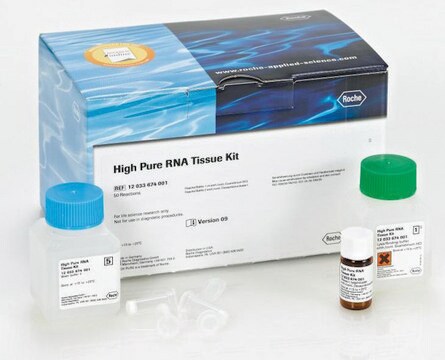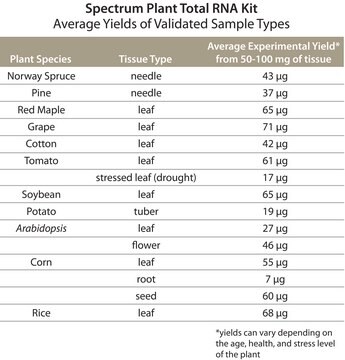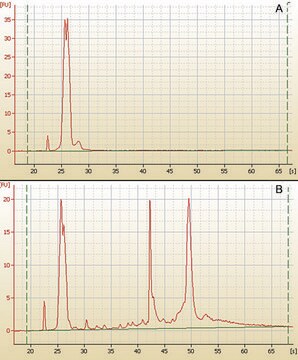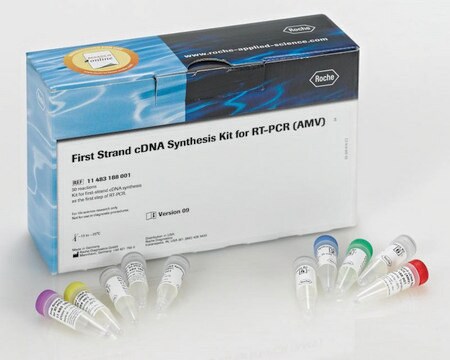04823125001
Roche
High Pure FFPE RNA Micro Kit
kit of for 50 isolations
About This Item
Productos recomendados
fabricante / nombre comercial
Roche
envase
kit of for 50 isolations
Categorías relacionadas
Descripción general
Aplicación
- Qualitative RT-PCR
- Relative quantification of mRNA with real-time PCR systems such as the LightCycler® 480 System
- Differential display RT-PCR
- cDNA synthesis
- Primer extension
Características y beneficios
Size Distribution: The typical size of RNA isolated from formalin-fixed tissue ranges from 150 to 1500 bases. However, section thickness, tissue type, age of sample, and the fixation protocol used can affect the yield and quality of the isolated RNA.
Capacity: The High Pure Micro Filter Tubes hold up to 500 μl sample volume.
Sample Material: 1 - 10 μm sections from formalin-fixed, paraffin-embedded (FFPE) tissue (e.g., from colon, breast, liver, kidney, spleen of mammalian species).
- Streamline and simplify RNA isolation (even small RNA fragments) from FFPE tissue.
- Obtain a highly concentrated, ready-to-use eluate and excellent recovery of RNA (>80%).
- Isolate DNA-free RNA for use in qualitative and quantitative RT-PCR.
- Minimize RNA loss with a kit that removes contaminants without precipitation or other handling steps that degrade RNA.
- Generate high-quality template RNA that shows excellent performance and linearity in RT-PCR.
Componentes
- Tissue Lysis Buffer
- Proteinase K, recombinant, PCR Grade
- Binding Buffer
- Wash Buffer I
- Wash Buffer II
- DNase I, recombinant, lyophilized
- DNase Incubation Buffer
- Elution Buffer
- High Pure Micro Filter Tubes
- Collection Tubes
Calidad
The RNA eluate and specific primers for the ß2M gene are used in one-step RT-PCR. In the following PCR on the LightCycler® 2.0 Instrument (accomplished using the LightCycler® RNA Amplification Kit SYBR Green I and specific primers for β2M), the expected amplification signal is obtained at a Cp-value less than 24.
Absence of contaminating genomic DNA is examined by PCR on a LightCycler® 2.0 Instrument without a reverse transcriptase step; no amplification product is obtained.
Nota de preparación
Under the buffer conditions used in the procedure, all nucleic acids bind specifically to the glass fiber fleece, while contaminating substances (salts, proteins, and other tissue contaminants) do not. DNA in the preparation is digested with DNase I directly on the filter. Brief wash-and-spin steps readily remove the digested DNA fragments and other contaminating substances. The remaining purified RNA is then eluted in a small volume of low-salt buffer.
Nota de análisis
Starting Material and Quantity: 1 - 10 μm FFPE sections, colon, breast, liver, kidney, spleen of mammalian species
Yield/Recovery: 1.5 - 3.5 μg/5 μm section
Time Required: 60 minutes without 3 hour incubation
Number of Reactions: 50/1-10 μm sections
Información legal
Palabra de señalización
Danger
Frases de peligro
Clasificaciones de peligro
Acute Tox. 4 Dermal - Acute Tox. 4 Inhalation - Acute Tox. 4 Oral - Aquatic Chronic 3 - Eye Dam. 1 - Resp. Sens. 1 - Skin Corr. 1C - Skin Sens. 1 - STOT SE 3
Órganos de actuación
Respiratory system
Riesgos supl.
Código de clase de almacenamiento
13 - Non Combustible Solids
Clase de riesgo para el agua (WGK)
WGK 2
Punto de inflamabilidad (°F)
does not flash
Punto de inflamabilidad (°C)
does not flash
Certificados de análisis (COA)
Busque Certificados de análisis (COA) introduciendo el número de lote del producto. Los números de lote se encuentran en la etiqueta del producto después de las palabras «Lot» o «Batch»
¿Ya tiene este producto?
Encuentre la documentación para los productos que ha comprado recientemente en la Biblioteca de documentos.
Los clientes también vieron
Nuestro equipo de científicos tiene experiencia en todas las áreas de investigación: Ciencias de la vida, Ciencia de los materiales, Síntesis química, Cromatografía, Analítica y muchas otras.
Póngase en contacto con el Servicio técnico










